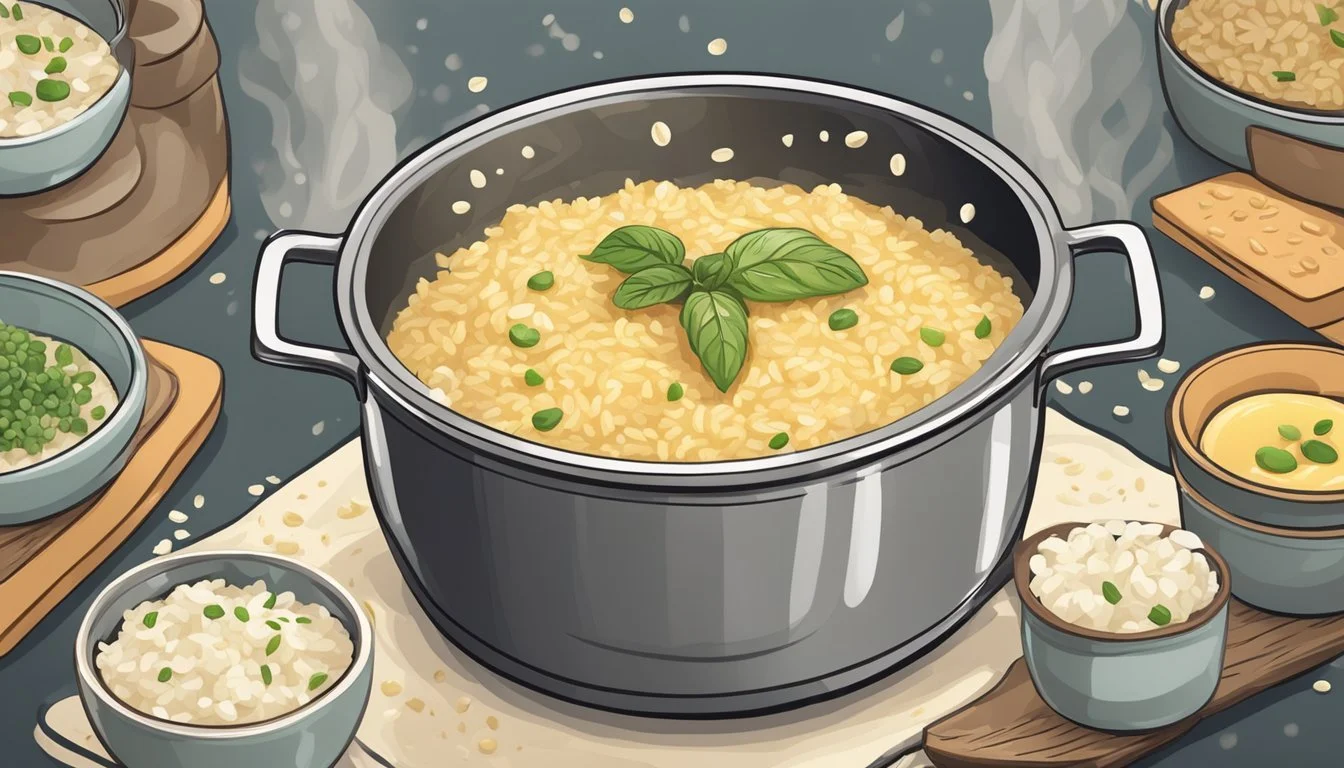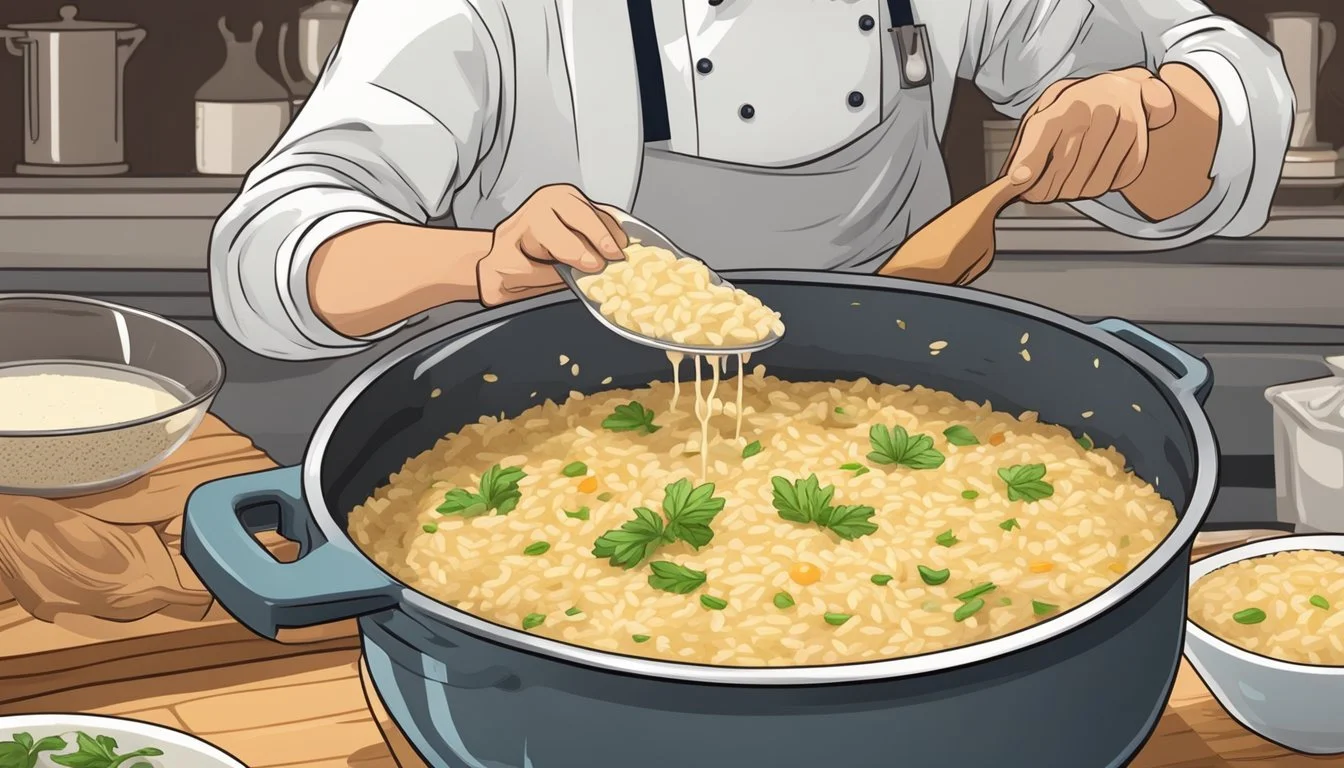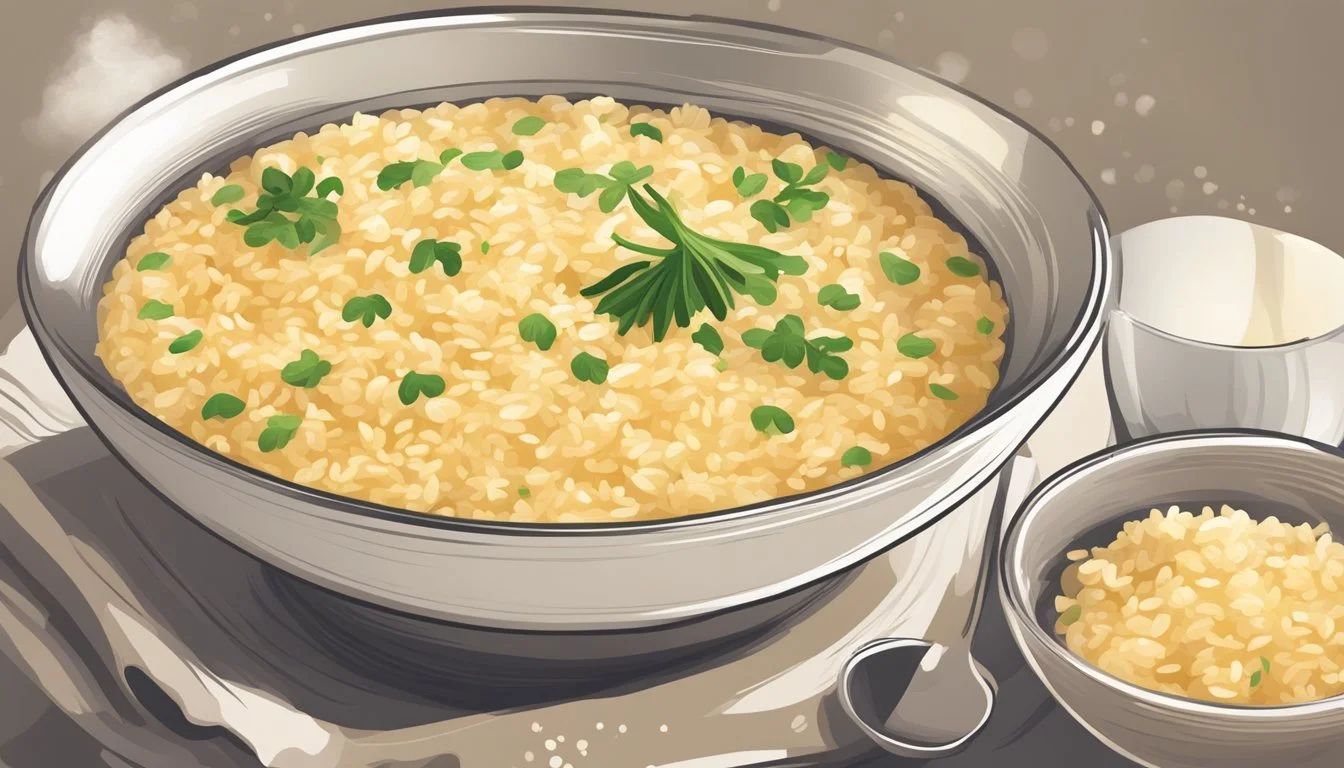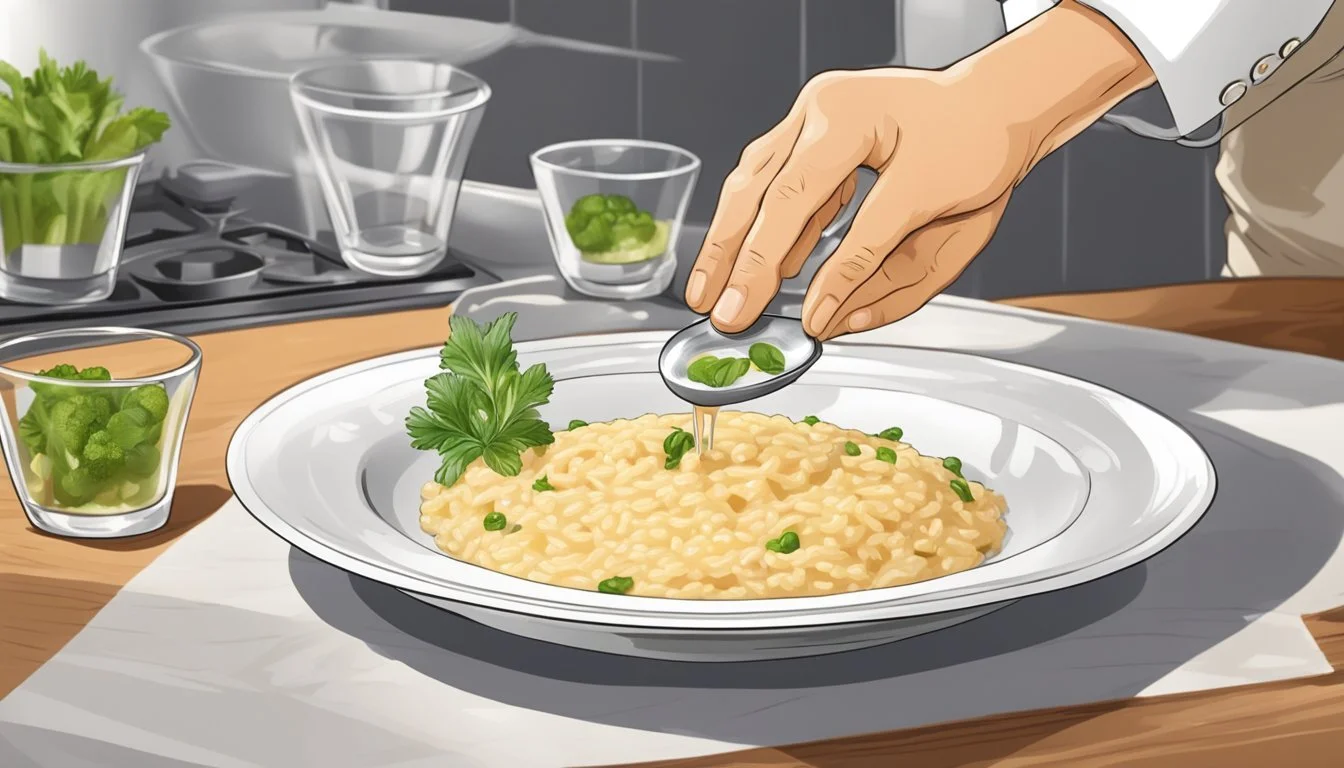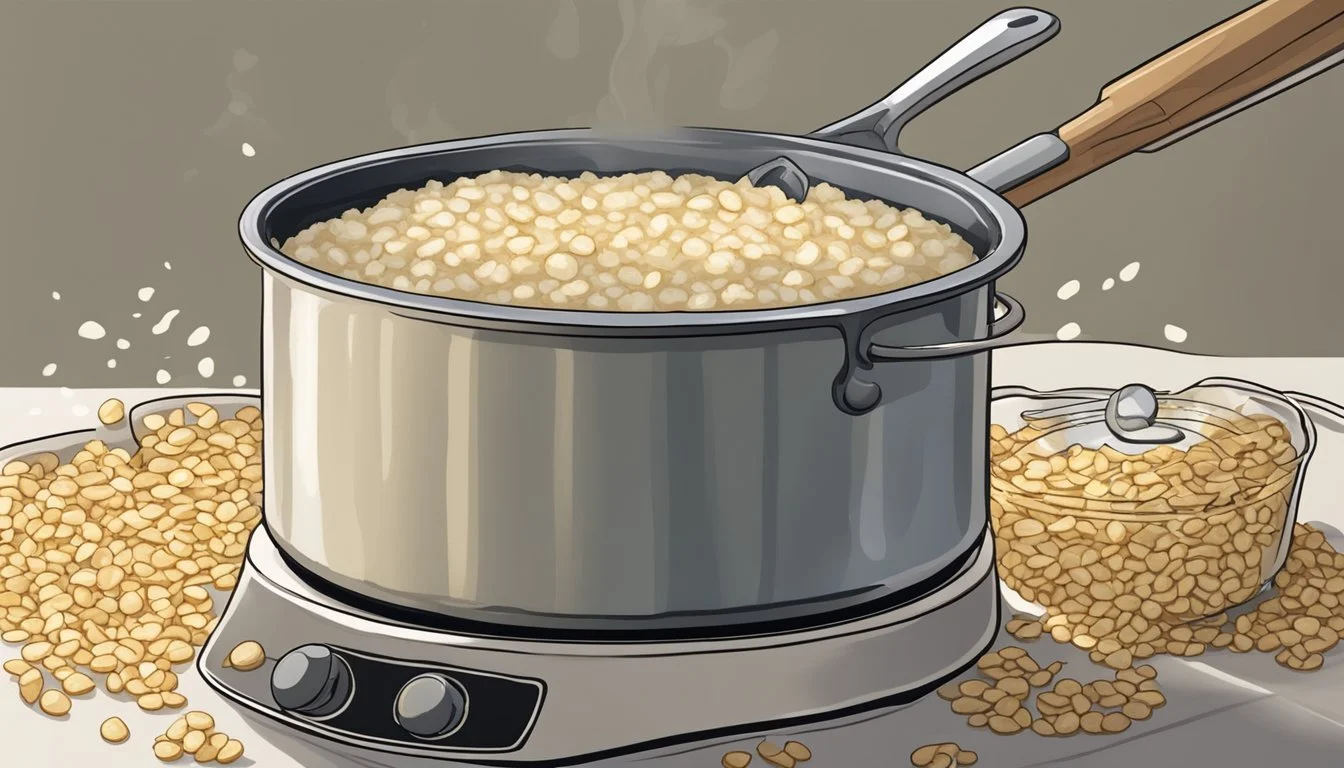Saving Overcooked Risotto
Tips for Reviving Your Dish to Creamy Perfection
Overcooking risotto often leads to a dish that's far from the creamy, al dente consistency chefs strive for. However, a risotto that has spent a bit too long on the stove isn't destined for the trash. The absorption method typically used in cooking risotto, which involves stirring hot stock into arborio rice, leaves room for maneuver even when the rice has been overcooked. Home cooks can rescue their overcooked risotto and still achieve a meal that's rich, creamy, and indulgent.
While many imagine that an overcooked risotto is a complete disaster, there are several creative adjustments one can make to salvage it. These methods employ additions like stock, dairy, and careful reheating to add moisture back into the rice and to reintegrate a creamy texture. This approach can also transform the dish into something new and equally delightful, such as turning the risotto into a savory rice cake or a comforting soup, demonstrating the versatility and forgiving nature of this Italian classic.
By treating the overcooked grains as an opportunity rather than a setback, cooks can explore the breadth of risotto's potential. This not only reduces food waste but also serves as an excellent lesson in the art of culinary problem-solving. With a few key techniques, anyone can turn an overcooked risotto into a dish that is once again worthy of the dinner table.
Understanding Risotto
Risotto stands as a testament to the elegance of Italian cuisine, a creamy rice dish that hinges on specific methods and ingredients for its unique texture and flavor.
What Is Risotto?
Risotto is a northern Italian rice dish cooked with broth until it reaches a creamy consistency. The broth can be derived from meat, fish, or vegetables. Many variations of risotto contain butter, onion, white wine, and Parmesan cheese. It's known for its creamy texture which comes from the starch of the rice, released during the slow cooking process.
Types of Rice for Risotto
The success of a risotto lies significantly in the type of rice used. The preferred varieties include:
Arborio: This is the most widely available risotto rice with a shape that's shorter and fatter than other rices. It's valued for its high starch content which lends to the creaminess of the dish.
Carnaroli: Often known as the 'king of rice', Carnaroli has a higher starch content and firmer texture, which holds its shape better during cooking.
Vialone Nano: A variety that comes from the Veneto region, Vialone Nano is smaller than Carnaroli but is highly absorbent, resulting in an especially creamy risotto.
Key Ingredients
The key ingredients of a classic risotto recipe include:
Rice: Specifically Arborio, Carnaroli, or Vialone Nano.
Broth: Vegetable, chicken, beef, or seafood, kept warm and added gradually.
Aromatics: Onion or shallot, finely chopped and sweated in fat at the beginning.
Fat: Usually butter, olive oil, or a combination for richness and flavor.
Wine: A splash of white wine provides acidity to balance the richness.
Dairy: Parmesan cheese and sometimes butter, added off the heat to create a creamy finish.
Italian Risotto Traditions
Risotto reflects the essence of Italian cuisine, highlighting regional ingredients and meticulous cooking techniques. Tradition demands that one stir the risotto gently and consistently after adding each ladle of hot broth, allowing a gradual release of starch. This traditional Italian dish is often served as a primo, a course that precedes the secondo, or main course. Each region in Italy may have its own traditional risotto dish, like Risotto alla Milanese, which is distinguished by saffron, or Risotto al Nero di Seppia from Venice featuring cuttlefish and ink.
Mastering the Basics
Before diving into how to save an overcooked risotto, it's important to master the essential techniques of making this creamy rice dish. Precise preparation, the quality of stock, and faithful stirring define the success of a risotto.
Risotto Preparation Methods
To start, chefs need the appropriate type of rice: Arborio or Carnaroli are preferred for their high starch content which contributes to the creamy texture. The rice is first toasted in a saucepan, a step crucial for preventing the grains from becoming mushy. This is done by sautéing the rice in butter (or oil) over medium heat to coat each grain in fat, which tempers the absorption of liquid and helps maintain its structure.
Preparation Method:
Heat butter in a saucepan.
Toast the rice on medium heat.
The Importance of Stock
A stock of high quality is the lifeline of the dish, imparting depth and flavor. It should be kept hot in a separate saucepan and added gradually to the rice. Whether using chicken, vegetable, or beef stock, it should be incorporated one ladle at a time, allowing the rice to absorb the liquid before adding more. Temperature control is key; keeping the stock at a low heat on the stove will help maintain the risotto's temperature throughout cooking.
Stock Tips:
Use fresh, flavorful stock.
Keep stock at low heat.
Stirring: A Crucial Step
Frequent stirring is not a myth when it comes to risotto. It releases the rice's starch, contributing to the creaminess without the need for cream. A wooden spoon is typically used for its gentle effect on the grains. Consistent stirring prevents sticking and ensures even cooking. Additionally, it helps incorporate air, making the risotto fluffier and lighter, transforming it from a dense side dish to a delicate main.
Stirring Technique:
Use a wooden spoon.
Stir gently to avoid breaking the rice grains.
Through attentive preparation, proper use of stock, and continuous stirring, chefs create a risotto that's creamy and indulgent — an ideal canvas for a variety of flavors and additions.
Risotto Recipes and Variations
The versatility of risotto allows for classic recipes to shine while also providing a canvas for variations both creamy and inventive. Utilizing staple ingredients like short-grain rice, white wine, and Parmesan cheese, chefs and home cooks alike can create a diverse range of risotto dishes catered to various tastes.
Classic Risotto Recipe
The foundation for many variations, a Classic Risotto Recipe starts with short-grain rice such as Arborio or Carnaroli. Key to nailing the texture is the gradual addition of warm stock, often chicken or vegetable, allowing the rice to absorb the liquid slowly. A splash of dry white wine adds depth of flavor, while grated Parmesan cheese lends a rich, savory finish.
Ingredients:
Short-grain rice
Warm stock (chicken or vegetable)
Dry white wine
Grated Parmesan cheese
Butter
Onion, finely chopped
Garlic, minced (optional)
Creamy Mushroom Risotto
For Creamy Mushroom Risotto (What wine goes well with mushroom risotto?), one begins by sautéeing mushrooms until they're golden and aromatic. Thereafter, these are incorporated into the risotto where they infuse the dish with their umami flavor. A generous sprinkle of Parmesan cheese combines with the natural starches of the rice, culminating in a luxuriously creamy texture.
Key Variations:
Sauteed mushrooms (button, shiitake, or oyster)
Extra cream or butter for added richness
Fresh herbs such as thyme or parsley to garnish
Innovative Risotto Dishes
Turning to Innovative Risotto Dishes, creativity leads the way. For example, taking inspiration from the sea, risotto can be enhanced with succulent shrimp, swapping traditional stock for one made from shrimp shells. Or one might experiment with various cheeses like Gorgonzola or smoked mozzarella, each adding a unique twist to the classic Parmesan Risotto profile.
Innovations Include:
Shrimp stock and cooked shrimp added at the end
Exchange Parmesan for other cheeses
Incorporation of seasonal vegetables or spices
By sticking to the basic technique and incorporating these variations, one can ensure that even an overcooked risotto can be transformed into a creamy, indulgent meal. Risotto's forgiving nature makes it a perfect dish to experiment with and enjoy in a multitude of ways.
Tips for Perfect Risotto
In crafting the ideal risotto, one must focus on texture and flavor. Precision in these areas defines a stellar dish.
Achieving the Right Texture
Risotto's texture is paramount; it should be creamy without being mushy. Utilize a short-grain rice such as Arborio or Carnaroli, which holds its shape while releasing starch necessary for creaminess. It begins with toasting the rice in olive oil or butter to prime it for liquid absorption. One should add broth — preferably warm — gradually, about 3/4 cup at a time. Stir constantly, and wait until each addition is almost fully absorbed before introducing more broth. This meticulous process should take around 18-20 minutes, and the rice should retain a slight bite (al dente).
To enhance creaminess post-cooking, employ the Italian technique of mantecatura which involves vigorously stirring in cold butter and grated Parmesan cheese off the heat. This final touch elevates the risotto's texture, making it uniformly smooth and indulgent.
Balancing Flavors
Flavor balance in risotto relies on the interplay of savory broth, aromatic vegetables, and assertive seasonings like salt and pepper. Start by sautéing onion until soft, which provides a sweet, translucent base. Introducing garlic adds pungent undertones, but it should be added in the last minute of sautéing the onion to prevent burning. The quality of the broth is also fundamental; a rich, flavorsome stock infuses every grain of rice with depth.
Liberal seasoning is crucial, but one must taste continually and adjust salt and pepper progressively to prevent overpowering the dish. Near the end of cooking, folding in a touch of cream can enrich the flavor profile and compensate for any dryness that may have occurred during the absorption process. Garnish with fresh herbs, which not only add color but a fresh contrast to the rich, creamy base of the risotto.
Saving Overcooked Risotto
Even the most seasoned cooks can occasionally overcook risotto, but there are reliable strategies to save it from waste. These techniques focus on returning a creamy texture to the dish or transforming the overcooked risotto into a new, enjoyable meal.
Rescue Strategies for Overcooked Risotto
Adding Liquid: One can often salvage an overcooked risotto by incorporating a small amount of broth. The liquid should be added gradually while stirring gently to avoid breaking the rice grains.
Chicken, vegetable, or beef broth: Recommended for enhancing flavor.
Water: A viable option in the absence of broth, though it may dilute the taste.
The goal is to reintroduce moisture gradually until the desired consistency is achieved. Gentle heat and patience are key as the additional liquid is absorbed, helping to restore a semblance of creaminess.
Creating New Dishes from Leftovers
Arancini: These are crispy rice balls made from leftover risotto, which can be rolled, breaded, and deep-fried. They make a deliciously indulgent appetizer or snack.
Patties: Overcooked risotto can be shaped into patties and pan-fried. This is an excellent way to repurpose leftovers into a meal with a pleasing texture and taste.
When reheating risotto to make these new dishes, it's critical to do so gently:
Microwave: Heat in short intervals, stirring between each to evenly distribute warmth.
Stovetop: Add liquid and reheat slowly on low heat, stirring occasionally.
These methods maintain the risotto's integrity and prepare it for its transformation into a delightful dish. Whether it’s by enhancing the creamy texture directly or repurposing the risotto into arancini or patties, one can ensure that no risotto goes to waste.
Dietary and Nutritional Considerations
When considering the dietary and nutritional aspects of risotto, it is crucial to be cognizant of its caloric content and the availability of healthier alternatives which can cater to various dietary needs without sacrificing flavor.
Risotto Caloric Content
A standard 100-gram serving of risotto can contain approximately 368 calories. It is composed of about 6.1 grams of fat, 1193mg of sodium, 66.7 grams of carbohydrate, with sugars around 7 grams and protein about 12.3 grams. These values may vary based on ingredients and preparations from different brands.
Healthier Risotto Options
To create a healthier version of risotto:
Use low-calorie ingredients: Opt for low-fat cheeses and lean proteins.
Incorporate vegetables: Adding a variety of vegetables can enhance the nutritional profile without considerably increasing the caloric content.
Utilize vegetable broth: By replacing traditional broths with vegetable broth, one can reduce the sodium content and cater to plant-based diets.
Mind the portion size: Serving smaller portions can help in managing calorie intake.
By making mindful ingredient swaps and portion control, one can enjoy risotto that is both nutritious and in line with their dietary goals.
Serving and Presentation
When a dish such as risotto is overcooked, it's essential to focus on service and presentation to enhance its appeal. The right accompaniments can balance textures and elevate flavors, while thoughtful plating can turn even a humble dish into a visual feast.
Accompaniments and Toppings
The addition of select toppings and accompaniments can transform an overcooked risotto. Adding a dollop of heavy cream can reintroduce a creamy consistency. A sprinkle of fresh herbs, like parsley, can add a burst of freshness and color. To provide a contrasting texture, one might consider adding the crunch of toasted nuts or the crispness of a roasted chicken (What wine goes well with roasted chicken?) skin garnish. To finish, a generous grating of Parmesan cheese over the top adds a rich, savory note that complements the creaminess of the risotto.
Plating Techniques
The artful arrangement on the plate is crucial for presenting an overcooked risotto in the most appetizing way. Begin by using a warm, shallow bowl to serve the risotto; its breadth allows for even distribution of heat and showcases the creaminess. Carefully spoon the risotto into the center, allowing it to spread naturally. If integrating a component such as roasted chicken, place it atop the risotto at a jaunty angle to create height and visual interest. A simple garnish of parsley not only adds a splash of color but also provides a fresh aroma upon serving. Remember, the objective is to make each plate look inviting and abundant, a feast for the eyes as much as for the palate.
Storing and Reheating Risotto
Proper storage and reheating are crucial for keeping leftover risotto creamy and indulgent. This section provides essential tips on how to store and reheat risotto to preserve its texture and flavor.
How to Store Leftover Risotto
After enjoying a creamy risotto, it's important to store any leftovers correctly to maintain its quality. One should transfer the leftover risotto into an airtight container as soon as it cools down. Here is a step-by-step guide:
Allow to cool: Give the risotto time to cool to avoid bacterial growth, but do not leave it at room temperature longer than two hours.
Transfer: Move the cooled risotto to an airtight container to minimize exposure to air.
Refrigerate: Place the container in the refrigerator, where the risotto can be safely stored for up to 5 days.
Best Practices for Reheating
Reheating risotto requires attention to detail to ensure even cooking while maintaining its creamy texture. Below are the recommended methods:
Stovetop Method:
Add liquid: For each cup of risotto, heat 2-3 tablespoons of low-sodium chicken, vegetable, or beef broth. Water is an alternative if no broth is available.
Heat: Place the risotto in the pan once the liquid is hot. Reheat over low to medium heat for 4-5 minutes, stirring frequently, until evenly heated and creamy.
Microwave Method:
Prepare: Place the risotto in a microwave-safe dish. Add a small amount of liquid, such as a broth, to provide moisture.
Cover: Loosely cover the dish with a microwave-safe lid or damp paper towel.
Heat: Use 30-second intervals, stirring well between each to promote even heating, until the risotto is thoroughly warmed.
By following these storage and reheating practices, one can enjoy leftover risotto that remains as creamy and indulgent as when it was first prepared.
Advanced Risotto Techniques
Mastering risotto requires an understanding of the subtleties of cooking methods. The following techniques, one for the oven and another for the stovetop, offer distinct approaches to achieve creamy, perfectly cooked risotto.
The Hands-Off Oven Method
To prepare risotto using the hands-off oven method, one must first toast the Arborio rice lightly in a pan with a bit of oil, which coats the grains and lends a depth of flavor. Then, simmering stock is added. Here's a brief outline:
Preheat your oven to a moderate temperature (around 350°F).
In an oven-safe pan, toast the rice with oil or butter until it's slightly golden.
Stir in simmering stock, usually in a 4:1 ratio – liquid to rice.
Cover the pan with a tight lid or foil and place it in the oven.
This method allows the rice to cook evenly and absorb the stock without the need for continuous stirring, making it a more forgiving and time-efficient approach to risotto.
Cooking Risotto on the Stovetop
Stovetop risotto is the classic technique favored for its control over the cooking process. The goal is to constantly stir the rice while slowly adding hot stock to achieve the signature creamy texture. One must remain vigilant and keep the following steps in mind:
Keep the stock at a gentle simmer on one burner.
On another burner, use a wide, heavy-bottomed pot to maintain even heat distribution.
Toast the rice until each grain is translucent with a white spot in the center.
Add the simmering stock in increments, allowing the rice to absorb most of the liquid before adding more.
Stirring often is critical for releasing the rice's starches, creating that indulgent creaminess associated with a quintessential stovetop risotto.
Incorporating Risotto into the Menu
When carefully prepared, risotto offers versatility on the menu, serving both as a comforting main dish and as an elegant side dish. Its velvety texture and ability to incorporate various ingredients make risotto a staple for family meals and fine dining alike.
Risotto as a Main Dish
Risotto shines as a main dish when it's the star of the meal. Using ingredients like succulent chicken, earthy mushrooms, and a hint of saffron, chefs can transform overcooked risotto into a dish that is both comforting and indulgent. It's important to balance the flavors and ensure that the rice retains a creamy consistency, even when reheated or adjusted.
Chicken & Mushroom Risotto: A classic choice where the tender chicken complements the richness of the mushrooms.
Saffron Risotto: Adding saffron creates a vibrant and aromatic centerpiece.
Risotto as a Side Dish
As a side dish, risotto's velvety texture complements a variety of main courses, from grilled meats to baked fish. It should be seasoned well but not overpower, allowing the main dish to take the spotlight.
Steamed Broccoli Risotto: Incorporate steamed broccoli for a nutritious twist and a pop of color.
Fennel Orange Risotto: A light and citrus-infused risotto can be a refreshing accompaniment, pairing well with heartier meats.
In both roles, chefs must pay attention to consistency and flavor to ensure that risotto maintains its reputation as a staple comfort food.
Culinary Insights and History
Risotto, the creamy rice dish from Italy, has a culinary legacy that has evolved significantly over the centuries. Its transition from a local staple to a global phenomenon reflects the adaptability and enduring appeal of Italian cuisine.
The Evolution of Risotto in Italian Cuisine
Originating in the northern regions of Italy, risotto's history is intertwined with the cultivation of short-grain rice varieties like Arborio and Carnaroli. The technique of stirring rice with broth until it achieves a creamy consistency is thought to have been developed during the Middle Ages. It was in Milan where risotto alla milanese emerged, characterized by the lavish use of saffron, which was originally intended to dye glass. Over time, it became one of the most emblematic dishes of Italian cookery, showcasing the simplicity and richness of local ingredients through careful preparation.
Influence of Risotto on Global Cuisine
Risotto's influence has expanded well beyond the confines of Italian borders. Chefs around the world have embraced the dish, adapting it to their local palates and ingredient availability. This Italian import has been customized in various cuisines, using different types of grains, unique ingredients like coconut milk, and even making vegetarian and vegan iterations that adhere to contemporary dietary preferences. As a testament to Italian cuisine's global impact, it's not uncommon to find risotto featured prominently in the menus of high-end restaurants as well as being adapted for quick home cooking solutions. Its presence around the world serves as a testimony to the blend of tradition and innovation that continues to characterize Italian culinary practices.

